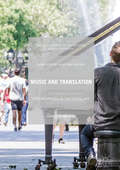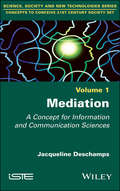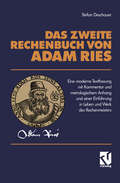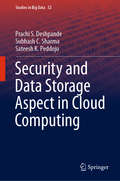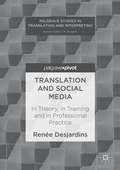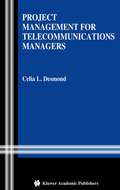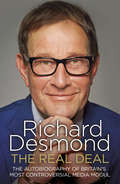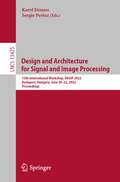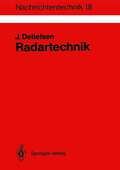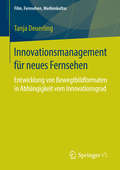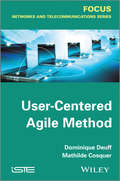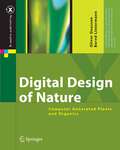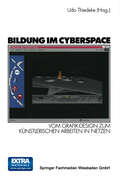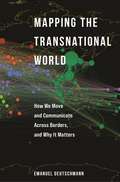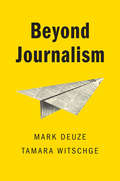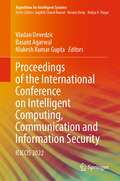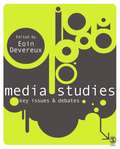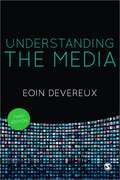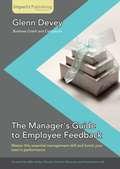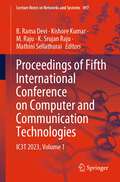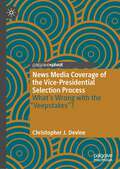- Table View
- List View
Music and Translation: New Mediations in the Digital Age (Palgrave Studies in Translating and Interpreting)
by Lucile DesblacheThis book explores how transformations and translations shape musical meanings, developments and the perception of music across cultures. Starting with the concept of music as multimodal text, the author understands translation as the process of transferring a text from one language – verbal or not – into another, interlingually, intralingually or intersemiotically, as well as the products that are derived from this process. She situates music and translation within their contemporary global context, examining the tensions between local and global, cosmopolitan and national, and universal and specific settings, to arrive at a celebration of the translational power of music and an in-depth study of how musical texts are translated. This book will be of interest to translation studies scholars who want to broaden their horizons, as well as to musicians and music scholars seeking to understand how cultural exchange and dissemination can be driven by translation.
Mediation: A Concept for Information and Communication Sciences
by Jacqueline DeschampsMediation is a very old practice that has been reborn to meet the needs of the contemporary world. It is thus increasingly present in today's societies. This book presents the theoretical foundations of mediation, as well as the way in which teachers and researchers in Information and Communication Sciences (ICS) have taken up this concept. Whether it is communicational, informational, cultural, organizational or societal, mediation belongs to a field of research, instituted by ICS, which sees in it a process of overcoming conflict, restoring communication and deconstructing social connections. Mediation: A Concept for Information and Communication Sciences inaugurates this set through its contribution to a state of the art of the theory and concepts used by the ICS community. It is addressed to teachers, researchers and students, as well as information professionals wishing to think about their daily practice.
Mediation: A Concept for Information and Communication Sciences
by Jacqueline DeschampsMediation is a very old practice that has been reborn to meet the needs of the contemporary world. It is thus increasingly present in today's societies. This book presents the theoretical foundations of mediation, as well as the way in which teachers and researchers in Information and Communication Sciences (ICS) have taken up this concept. Whether it is communicational, informational, cultural, organizational or societal, mediation belongs to a field of research, instituted by ICS, which sees in it a process of overcoming conflict, restoring communication and deconstructing social connections. Mediation: A Concept for Information and Communication Sciences inaugurates this set through its contribution to a state of the art of the theory and concepts used by the ICS community. It is addressed to teachers, researchers and students, as well as information professionals wishing to think about their daily practice.
Das Zweite Rechenbuch Von Adam Ries: Eine moderne Textfassung mit Kommentar und metrologischem Anhang und einer Einführung in Leben und Werk des Rechenmeisters
by Stefan DeschauerSecurity and Data Storage Aspect in Cloud Computing (Studies in Big Data #52)
by Prachi S. Deshpande Subhash C. Sharma Sateesh K. PeddojuThis book analyses the various security threats in cloud computing. A host-based IDS (HIDS) using signature verification is developed and implemented for the concerned security issues. Further, owing to the vulnerability of distributed denial of service (DDoS) attacks in cloud computing, a network based IDS (NIDS) is developed and implemented against such attacks. The performance of these IDS is verified in the Cloud scenario as well against the standard data set. Finally, a simple data storage and security model is developed and implemented for the Cloud computing scenario. The contents of this book will be of interest to researchers and professionals alike.
Translation and Social Media: In Theory, in Training and in Professional Practice (Palgrave Studies in Translating and Interpreting)
by Renée DesjardinsOffering a discussion of translation and social media through three themes, theory, training and professional practice, this book builds on emerging research in Translation Studies, including references citing recent translation and social media industry data. Topics include the translation of hashtags and the relevance of indexing, among others.
Project Management for Telecommunications Managers
by Celia L. DesmondThis concise reference covers important aspects of project management. It explains many key concepts in layman's terms, provides tools for planning, organizing, tracking and managing projects and gives examples of various telecommunications projects from wireline and wireless providers, equipment vendors and component manufacturers.
The Real Deal: The Autobiography of Britain’s Most Controversial Media Mogul
by Richard DesmondFrom the age of five, when he helped his deaf father negotiate advertising contracts, Richard Desmond has always had an eye for business. In The Real Deal he offers a no-holds-barred account of an extraordinary career that has taken him from cloakroom attendant at a north London club to billionaire media owner. En route he tells of his early life as a rock and roll drummer, his first steps in the world of magazine publishing as a purveyor of leisure and top-shelf titles, and finally, after decades of paying his dues building smaller brands, his arrival in the big league with the launch of OK! magazine and the acquisition of Express Newspapers, his purchase and sale of Channel 5, and his £80 million investment in the Health Lottery, combining business innovation with help for good causes. Along the way, he imparts many of the secrets of his astounding success, as well as giving his forthright opinion (and he always has one) on such diverse subjects as politicians, religion, and the similarities between being a rock and roll drummer and running a business – as well as his views on a cast of characters ranging from Alan Sugar to Victoria Beckham and from Simon Cowell to Jennifer Aniston.Often controversial, frequently revelatory, always entertaining, The Real Deal is the brilliantly frank account of a life spent at the sharp end.
Design and Architecture for Signal and Image Processing: 15th International Workshop, DASIP 2022, Budapest, Hungary, June 20–22, 2022, Proceedings (Lecture Notes in Computer Science #13425)
by Karol Desnos Sergio PertuzThis book constitutes the thoroughly refereed conference proceedings of the First International Workshop on Design and Architecture for Signal and Image Processing, DASIP 2022, held in Budaypest, Hungary in June 2022. The 13 full included in the volume were carefully reviewed and selected from 32 submissions. They are organized in the following topical sections: leading signal, image and video processing and machine learning in custom embedded, edge and cloud computing architectures and systems.
Radartechnik: Grundlagen, Bauelemente, Verfahren, Anwendungen (Nachrichtentechnik #18)
by Jürgen DetlefsenInnovationsmanagement für neues Fernsehen: Entwicklung von Bewegtbildformaten in Abhängigkeit vom Innovationsgrad (Film, Fernsehen, Medienkultur)
by Tanja DeuerlingTanja Deuerling zeigt, wie die Entwicklung von Bewegtbildformaten im Spannungsfeld zwischen Kreativität und Management in jeder einzelnen Phase des Innovationsprozesses zielgerichtet gesteuert werden kann. Mit ihrem „Grad-Phasen-Modell“ lässt sich die Formatentwicklung in Abhängigkeit vom Innovationsgrad analysieren, strukturieren und managen: Je nachdem, wie innovativ ein Produkt des „neuen Fernsehens“ sein soll, verändern sich die Anforderungen an Organisation, Akteure und Prozesssteuerung. Das Buch liefert damit auf Basis von Erkenntnissen aus der Medienwissenschaft und -ökonomie sowie aus der Innovations- und Kreativitätsforschung einen handlungsorientierten Theorierahmen für die Medienproduktion sowie konkrete Empfehlungen zum Management von Bewegtbildinnovationen.
User-Centered Agile Method
by Dominique Deuff Mathilde CosquerAgile development methods began to emerge around 20 years ago. However, it was not until the early 2000s that they began to be widely used in industry. This growth was often due to the advent of Internet services requiring faster cycles of development in order to heighten the rate at which an ever-greater number of functionalities were made available. In parallel, user-centered design (UCD) methods were also becoming more and more widely used: hence, user-centered design and agile methods were bound to cross paths, at least in the telecoms industry! During this period, in the field of telecommunications, the explosion in the number of connected terminals, Web applications, new use environments (particularly in a domestic setting), etc., meant it was crucial to gain a fuller understanding of users’ requirements and better evaluate the relevance and acceptance of services’ attempts to cater for these requirements. Thus the user-centered agile method, as proposed in this book, aims to mutually integrate two existing methods: user-centered design – as used by ergonomists – and the agile Scrum method – as used by developers. The user testing method is also covered. Analyzing work on this subject spanning the past 10 years, the authors also provide an assessment of the feedback on the user-centered agile method. The method described in this book has been based on all these sources. It is a framework relying on the logic introduced by Scrum, i.e. a framework based on project management. The method proposed is seen as an extension of Scrum which is “centered on humans” because of the integration of user-centered design and user-testing. Therefore the description of the user-centered agile method is based on the basics of the agile Scrum method and uses its terminology and elements. As well as descriptive elements of the user-centered agile method, practical examples of how to implement it are also provided. Contents 1. Introduction. 2. Intrioduction to the Methods Employed. 3. Sources for this Work. 4. Description of The User-Centered Agile Method. 5. Case Studies. About the Authors Dominique Deuff worked at the National Institute of Informatics in Japan for 2½ years before coming back to France in June 2006 and joining Orange Labs France Telecom as a developer in a Scrum team. In 2008, she graduated with a Master’s degree in ergonomics and has since then been applying her new skills to various projects at Orange Labs Lannion. Mathilde Cosquer joined Orange Labs as an ergonomist after completing her PhD on the question of transparency of technical devices from the user’s point of view. She has taken part in the design and evaluation of numerous innovating services, but over the past four years, she has been more particularly involved in projects of interpersonal communication services.
User-Centered Agile Method
by Dominique Deuff Mathilde CosquerAgile development methods began to emerge around 20 years ago. However, it was not until the early 2000s that they began to be widely used in industry. This growth was often due to the advent of Internet services requiring faster cycles of development in order to heighten the rate at which an ever-greater number of functionalities were made available. In parallel, user-centered design (UCD) methods were also becoming more and more widely used: hence, user-centered design and agile methods were bound to cross paths, at least in the telecoms industry! During this period, in the field of telecommunications, the explosion in the number of connected terminals, Web applications, new use environments (particularly in a domestic setting), etc., meant it was crucial to gain a fuller understanding of users’ requirements and better evaluate the relevance and acceptance of services’ attempts to cater for these requirements. Thus the user-centered agile method, as proposed in this book, aims to mutually integrate two existing methods: user-centered design – as used by ergonomists – and the agile Scrum method – as used by developers. The user testing method is also covered. Analyzing work on this subject spanning the past 10 years, the authors also provide an assessment of the feedback on the user-centered agile method. The method described in this book has been based on all these sources. It is a framework relying on the logic introduced by Scrum, i.e. a framework based on project management. The method proposed is seen as an extension of Scrum which is “centered on humans” because of the integration of user-centered design and user-testing. Therefore the description of the user-centered agile method is based on the basics of the agile Scrum method and uses its terminology and elements. As well as descriptive elements of the user-centered agile method, practical examples of how to implement it are also provided. Contents 1. Introduction. 2. Intrioduction to the Methods Employed. 3. Sources for this Work. 4. Description of The User-Centered Agile Method. 5. Case Studies. About the Authors Dominique Deuff worked at the National Institute of Informatics in Japan for 2½ years before coming back to France in June 2006 and joining Orange Labs France Telecom as a developer in a Scrum team. In 2008, she graduated with a Master’s degree in ergonomics and has since then been applying her new skills to various projects at Orange Labs Lannion. Mathilde Cosquer joined Orange Labs as an ergonomist after completing her PhD on the question of transparency of technical devices from the user’s point of view. She has taken part in the design and evaluation of numerous innovating services, but over the past four years, she has been more particularly involved in projects of interpersonal communication services.
Digital Design of Nature: Computer Generated Plants and Organics (X.media.publishing)
by Oliver Deussen Bernd LintermannWhat is computer graphics and what are the conceptual tasks of research in this area? To the average person the term still conveys more or less the design of - gos and the manipulation of pictures with the help of image-editing programs. However, during the past four decades, computer graphics has evolved into an innovative multifaceted ?eld of research and computing that affects many other sciences. In many areas and for many problems we can best convey an und- standing through images that trigger our sense with the highest capability: our eye. And, what is more, aside from algorithms, formulas, and tables, the c- puter graphics scientist often is able to create beauty. Though it is a beauty of its own, it often fascinates the viewer, especially when complex aesthetic images emerge from simple mathematical concepts. Also, there are only a few other areas that advance as dynamically as inf- matics and especially computer graphics. While CPU capacity still increases and is almost doubled every 18 months, the rendering speed and ef?ciency of graphics boards has increased even more during recent years. Today, images can be rendered in real time that some years ago still required several hours of computing. Parallel to the rapid improvement of computer hardware, many newalgorithms weredevelopedthattoday form the basis for some fundamental changes and achievements in graphics.
Bildung im Cyberspace: Vom Grafik-Design zum künstlerischen Arbeiten in Netzen. Entwicklung und Erprobung eines Weiterbildungskonzeptes. Projektband 1
by Deutsches Inst. f. ErwachsenenbildungDie Verbreitung "neuer", computergestützter Medien verändert das Potenzial, Wissen zu erwerben und zu kommunizieren. So kann im Internet Bildungswissen individuell und außerhalb etablierter Bildungsinstitutionen erworben werden. Zugleich bietet sich den Nutzern die Möglichkeit, als Medienproduzenten selbstgestalteter Inhalte aufzutreten. Hierzu sind jedoch technische und kulturelle Kompetenzen im Umgang mit den neuen Medien Voraussetzung. Der vorliegende Band beleuchtet die Problematik kreativer Medienkompetenz als Grundlage einer erweiterten Bildung aus interdisziplinären Blickwinkeln und mit empirischem Bezug zu einem Modellprojekt der kulturellen Bildung, das von Bundesministerium für Wissenschaft, Forschung und Technologie unterstützt und vom Deutschen Institut für Erwachsenenbildung e.V. in Kooperation mit dem Institut für Neue Medien sowie verschiedenen Bildungseinrichtungen durchgeführt wurde.
Mapping the Transnational World: How We Move and Communicate across Borders, and Why It Matters (Princeton Studies in Global and Comparative Sociology)
by Emanuel DeutschmannA study of the structure, growth, and future of transnational human travel and communicationIncreasingly, people travel and communicate across borders. Yet, we still know little about the overall structure of this transnational world. Is it really a fully globalized world in which everything is linked, as popular catchphrases like “global village” suggest? Through a sweeping comparative analysis of eight types of mobility and communication among countries worldwide—from migration and tourism to Facebook friendships and phone calls—Mapping the Transnational World demonstrates that our behavior is actually regionalized, not globalized.Emanuel Deutschmann shows that transnational activity within world regions is not so much the outcome of political, cultural, or economic factors, but is driven primarily by geographic distance. He explains that the spatial structure of transnational human activity follows a simple mathematical function, the power law, a pattern that also fits the movements of many other animal species on the planet. Moreover, this pattern remained extremely stable during the five decades studied—1960 to 2010. Unveiling proximity-induced regionalism as a major feature of planet-scale networks of transnational human activity, Deutschmann provides a crucial corrective to several fields of research.Revealing why a truly global society is unlikely to emerge, Mapping the Transnational World highlights the essential role of interaction beyond borders on a planet that remains spatially fragmented.
Mapping the Transnational World: How We Move and Communicate across Borders, and Why It Matters (Princeton Studies in Global and Comparative Sociology)
by Emanuel DeutschmannA study of the structure, growth, and future of transnational human travel and communicationIncreasingly, people travel and communicate across borders. Yet, we still know little about the overall structure of this transnational world. Is it really a fully globalized world in which everything is linked, as popular catchphrases like “global village” suggest? Through a sweeping comparative analysis of eight types of mobility and communication among countries worldwide—from migration and tourism to Facebook friendships and phone calls—Mapping the Transnational World demonstrates that our behavior is actually regionalized, not globalized.Emanuel Deutschmann shows that transnational activity within world regions is not so much the outcome of political, cultural, or economic factors, but is driven primarily by geographic distance. He explains that the spatial structure of transnational human activity follows a simple mathematical function, the power law, a pattern that also fits the movements of many other animal species on the planet. Moreover, this pattern remained extremely stable during the five decades studied—1960 to 2010. Unveiling proximity-induced regionalism as a major feature of planet-scale networks of transnational human activity, Deutschmann provides a crucial corrective to several fields of research.Revealing why a truly global society is unlikely to emerge, Mapping the Transnational World highlights the essential role of interaction beyond borders on a planet that remains spatially fragmented.
Beyond Journalism
by Mark Deuze Tamara WitschgeIn the context of profound transformations in the professional, business, technological and social context of journalism, it is crucial for journalism studies and education to move beyond limited approaches to the discipline. Among the most significant changes affecting journalism worldwide is the emergence of startup culture, as more and more journalists strike out on their own. In Beyond Journalism, Deuze and Witschge combine extensive global and comparative fieldwork. Through rich case studies of journalism startups around the world, they provide deep insight into the promises and pitfalls of media entrepreneurship. Ultimately, they aim to recognize new and emerging voices as legitimate participants in the discourse about what journalism is, can be and should be. A bold manifesto as well as an in-depth empirical study, this book is essential reading for students and scholars of journalism, media, communication, and related disciplines.
Proceedings of the International Conference on Intelligent Computing, Communication and Information Security: ICICCIS 2022 (Algorithms for Intelligent Systems)
by Vladan Devedzic Basant Agarwal Mukesh Kumar GuptaThis book contains high quality research papers accepted and presented at the International Conference on Intelligent Computing, Communication and Information Security (ICICCIS 2022), organized by Swami Keshvanand Institute of Technology, Management & Gramothan (SKIT), Jaipur, India during 25-26, November 2022. It presents the solutions of issues and challenges in intelligent computing, communication and information security domains. This book provides a background to problem domains, considering the progress so far, assessing the potential of such approaches, and exploring possible future directions as a single readily accessible source.
Media Studies: Key Issues and Debates (PDF)
by Eoin DevereuxBringing together a range of renowned scholars in the field, this book examines eighteen key issues within contemporary media studies. Written in an accessible student-friendly style, Media Studies - Key Issues and Debates is an authoritative landmark text for undergraduate students. Each individual chapter begins with a concise definition of the concept(s) under investigation. This is followed by a 5,000 word discussion on the current state of play within research on the specific area. Chapters contain case-studies and illustrative materials from Europe, North America, Australasia and beyond. Each chapter concludes with annotated notes, which guide the student-reader in terms of future study. With a preface by Denis McQuail, contributors includeJanet McCabe, John Corner, David Croteau, William Hoynes, Natalie Fenton, Jenny Kitzinger, Jeroen de Kloet, Liesbet van Zoonen, Sonia Livingstone and Greg Philo.
Media Studies: Key Issues and Debates
by Eoin DevereuxBringing together a range of renowned scholars in the field, this book examines eighteen key issues within contemporary media studies. Written in an accessible student-friendly style, Media Studies - Key Issues and Debates is an authoritative landmark text for undergraduate students. Each individual chapter begins with a concise definition of the concept(s) under investigation. This is followed by a 5,000 word discussion on the current state of play within research on the specific area. Chapters contain case-studies and illustrative materials from Europe, North America, Australasia and beyond. Each chapter concludes with annotated notes, which guide the student-reader in terms of future study. With a preface by Denis McQuail, contributors include Janet McCabe, John Corner, David Croteau, William Hoynes, Natalie Fenton, Jenny Kitzinger, Jeroen de Kloet, Liesbet van Zoonen, Sonia Livingstone and Greg Philo.
Understanding the Media (PDF)
by Eoin DevereuxHow much of our media experience is shaped by the profit motive of media conglomerates? How much freedom and power do we have as members of an increasingly fragmented media audience? How do the media influence what we understand about friendship, globalization and even our own selves?
The Manager's Guide to Employee Feedback
by Glenn DeveyDrawing on tried and tested methods, you'll master feedback models through multiple approaches including a range of challenging feedback situations you're likely to find yourself in as a new manager. Packed with tips, advice, real life case studies and written with humour along the way, you'll soon be on your way to delivering a feedback and managing your team like a pro. If you are new to management and want to make a quick and lasting impression on your staff and employers, then “The New Manager's Guide to Giving Feedback”is for you. Feedback is an often talked about but poorly delivered topic, and this book will give you a shortcut to a valuable and rare skill in the workplace, setting you apart from your peers. If you're reading this because you want to develop yourself along with your staff, then the content in this book will do both, much quicker than you think!
Proceedings of Fifth International Conference on Computer and Communication Technologies: IC3T 2023, Volume 1 (Lecture Notes in Networks and Systems #897)
by B. Rama Devi Kishore Kumar M. Raju K. Srujan Raju Mathini SellathuraiThis book is a compilation of high-quality scientific papers presented at the 5th International Conference on Computer & Communication Technologies (IC3T 2023). The book covers cutting-edge technologies and applications of soft computing, artificial intelligence and communication. In addition, a variety of further topics are discussed, which include data mining, machine intelligence, fuzzy computing, sensor networks, signal and image processing, human–computer interaction, and web intelligence.
News Media Coverage of the Vice-Presidential Selection Process: What's Wrong with the "Veepstakes"?
by Christopher J. DevineThis book provides the first systematic, empirical analysis of the media’s approach to US vice-presidential selection (or the “veepstakes”). In their news coverage, Devine finds that media outlets typically treat vice-presidential selection as little more than a game—by focusing on how potential running mates might help to win the election, rather than how they might help the next president to govern. Based on an original content analysis of hundreds of veepstakes profiles from 2000–2020, this book quantifies the news media’s relative emphasis on various selection criteria, in general and across different electoral circumstances. The analysis suggests that journalists generally fail to serve the public interest by emphasizing electoral over governing considerations. However, Devine also points to positive examples of media coverage that help the public to evaluate potential running mates’ governing credentials, and suggests ways in which scholars, journalists, and citizens might encourage media outlets to provide more substantive, responsible coverage of the vice-presidential selection process in future elections.
